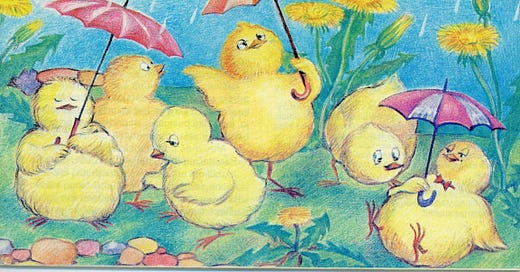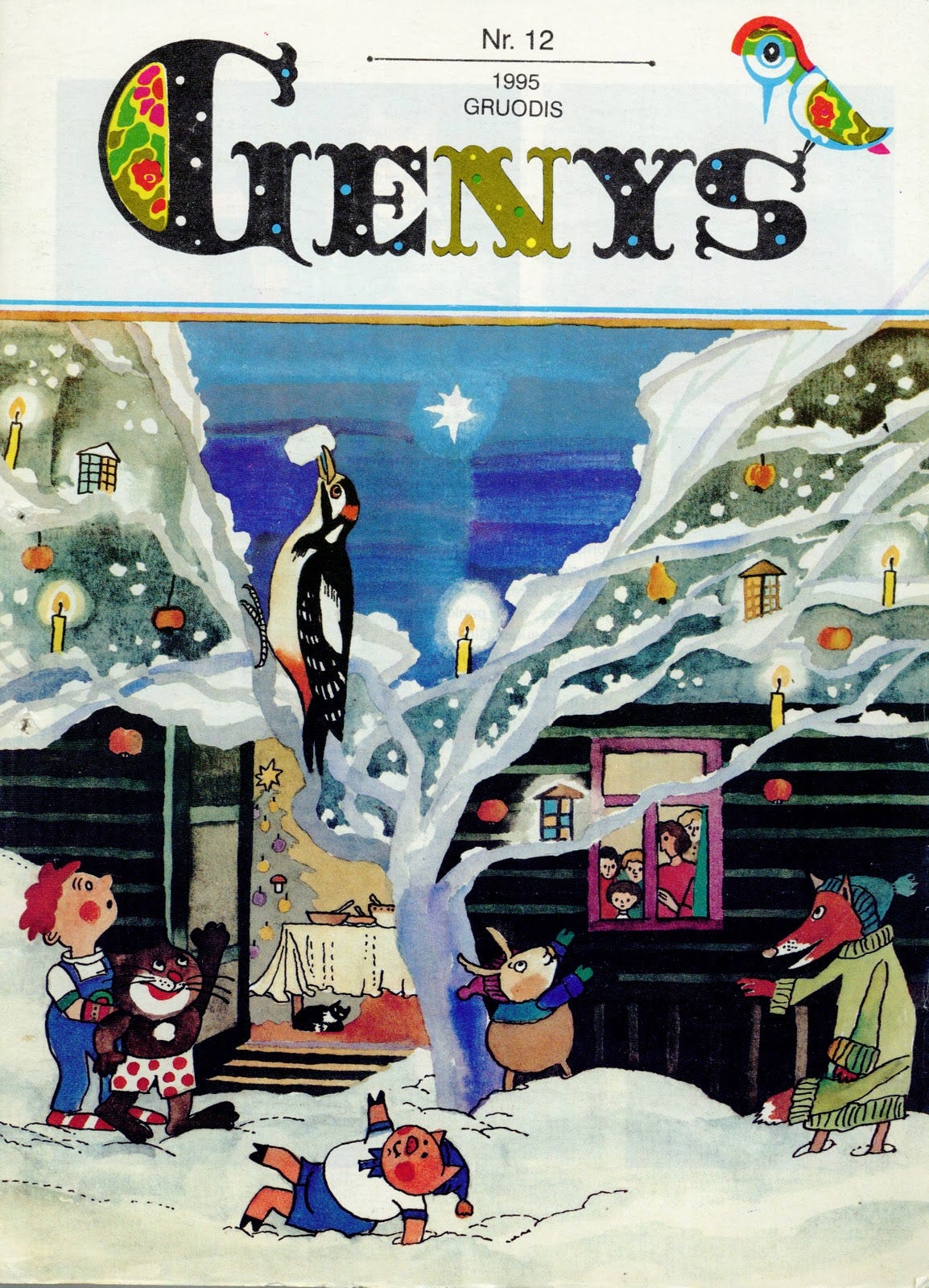When I was a kid, there was nothing I loved to read more than “Genys.”1
“Genys” (“woodpecker” in Lithuanian) was a monthly Lithuanian magazine for kids. I really loved it. There were fun comics, exciting stories, and beautiful drawings. For example, here’s the cover of the 1995 April edition of “Genys”:
I think it was “Genys” that made me interested in writing. In a weird roundabout way, the magazine also introduced me to probability theory.
What follows is the story of how that happened.
“Genys” lottery
“Genys” had great writing and lovely pictures of cute ducklings. It also had a lottery where you could win things.
The lottery worked like this. Each month, you would have 24 objects (for example, 24 different types of fruit). You would have to color 23 of these objects and leave 1 blank. Afterward, the good folks at “Genys” would randomly select one of the objects (e.g., lemon). If you left the lemon blank, you would win a prize.
Here’s what the lottery looked like:
As a kid, I wanted to choose my lucky object randomly. Or, maybe, not exactly randomly, but each week, I wanted to choose the thing that was most to my liking. My Dad, though, advised me to ignore my whims and stick to the object with the same order number.
Here’s what my Dad meant. Put a number from 1 to 24 on each fruit:
My Dad suggested always picking the same number, say, #2. I, instead, wanted to vary my choices.
Even as a kid, I found my Dad’s recommendation a bit odd. If the lucky item is chosen randomly, why does it matter what choice I make? On the other hand, it also felt like sticking to the same number made some sense. Like, sooner or later, #2 is due, right? You may as well stick to it.
A tale of two strategies
Many years later, I can now say which strategy—fixed or random betting—is better. For that, we will need some math.
Fair lottery
Let’s start by assuming that the lottery is fair. That is, a number from 1 to 24 is drawn, with each number equally likely; the draw is independent of any previous lottery draws.
In that case, if you always choose #2 (fixed betting strategy), the probability of winning is just 1/24.
Now consider the random-choice strategy. With the random strategy, the probability of winning is
So, the probability of winning is exactly the same—it’s 1/24.
In fact, it’s easy to demonstrate a more general result: No matter how you choose the lucky item, the probability of winning is always 1/24. So, for example, you could choose #1 with 2/3 probability and #19 with 1/3 probability, and the probability of winning would still remain 1/24.
What’s the intuition behind this? Imagine that you have a deck of 24 cards numbered from 1 to 24:
Someone from “Genys” shuffles the deck of cards perfectly and then hands it over to you. You can now choose between:
Picking the top card from the deck (“fixed betting strategy”);
Reshuffling the deck and then picking the top card (“random betting strategy”).
Since the deck is already fairly shuffled, it does not matter if you re-shuffle it again. That’s the same reason why fixed and random betting strategies are equally good in the “Genys” lottery.
Gambler’s fallacy
While the math is clear, it still feels like sticking to one number should pay off eventually. If #2 hasn’t come up in a while, doesn’t that increase the likelihood of #2 winning?
Actually, no. If the lottery is fair, the probability of #2 winning is always 1/24, regardless of how many times it hasn’t come up. This false belief that some number is due to win is the gambler’s fallacy. If the lottery is fair, it also has no memory; the lottery does not “remember” whether the last draw was #2 or any other number.
You could say my Dad fell prey to a cognitive error. However, I think that would be wrong.
Here’s a defense of my Dad’s proposal: Maybe the lottery just wasn’t fair. For example, if the lottery is fair, you easily get streaks, that is, the same number winning several times in a row. It’s easy to imagine that many children would get upset if #15 won three times in a row. It’s pretty likely that the folks at “Genys” would try to avoid such streaks.
Before you say that the fear of streaks is a made-up concern, consider Spotify’s randomization algorithm. Early on, Spotify’s shuffle mode used true randomization. That often yielded streaks: Users getting multiple songs from the same artist in a row. These streaks annoyed many Spotify users. To solve this problem, Spotify changed its shuffling algorithm to reduce streaks.
Unfair lottery
You could imagine the folks at “Genys” doing something similar to Spotify.
Suppose, as an extreme case, that “Genys” used the following algorithm to draw the lucky item:
Draw a number randomly (e.g., #1). That’s the lucky number for the first lottery;
For the next lottery, remove #1 from the list of potential winners. So, you’re only drawing from #2, #3, …, #24. Draw the lucky number from this reduced set;
Repeat this process until all numbers have been drawn.
What is the probability of winning now? Suppose you always bet on the same number (e.g., #2). For the first draw, the probability of winning is 1/24. For the second draw, assuming you didn’t win in the first draw, the probability of winning goes up to 1/23; if you won in the first round, the probability of winning becomes zero. In general, after N draws, the probability of winning is 1 / (24 - N) if you haven’t won already, or zero if you’ve already won.
If you always choose #2, you are guaranteed to win at some point in one of the 24 lotteries. In contrast, if you use the random strategy, you get the same payoff on average,2 but there’s a risk you’ll never win. Always choosing #2 is better.3
Conclusion
Let’s recap what we’ve found:
Fair lottery: It doesn’t matter what number you choose, the odds are always 1/24;
Unfair lottery that avoids streaks: Choosing the same number is a better strategy because it reduces risk.
I have no idea how “Genys” chose the winning number. However, all in all, the choose-the-same-number strategy seems to be better. You don’t lose anything if the lottery is fair, and you do strictly better if the lottery is rigged to avoid streaks.
Which strategy did I choose for the “Genys” lottery? I ended up following my Dad’s recommendation, and I always chose #2 as my lucky item. Whether due to luck or superior strategy, I did win once. The prize was a trip to a Coca-Cola factory, one of the highlights of my childhood.
So, that’s how “Genys” introduced me to probability. Thanks to “Genys” for this intro, and to my beloved parents for the subscription that started it all.
If you want to learn more about “Genys”, check out this great blog: http://kaskaitevienaturtis.blogspot.com/. All pictures from the magazine in this post are from that blog.
Let me flesh out the argument. Let’s say the value of winning the lottery is W (measured in dollars or utility units). If you use the fixed-number strategy, your expected payoff (over all 24 lotteries) is W. If you use the random strategy, your expected payoff is 24 * (1 / 24) * W = W. However, the probability is 1 that you win with the fixed-number strategy, while the probability of winning is only [1 - (1 - 1 / 24)^24] ≈ 0.64 with the random strategy.
Of course, you could do even better by making your strategy history-dependent.







